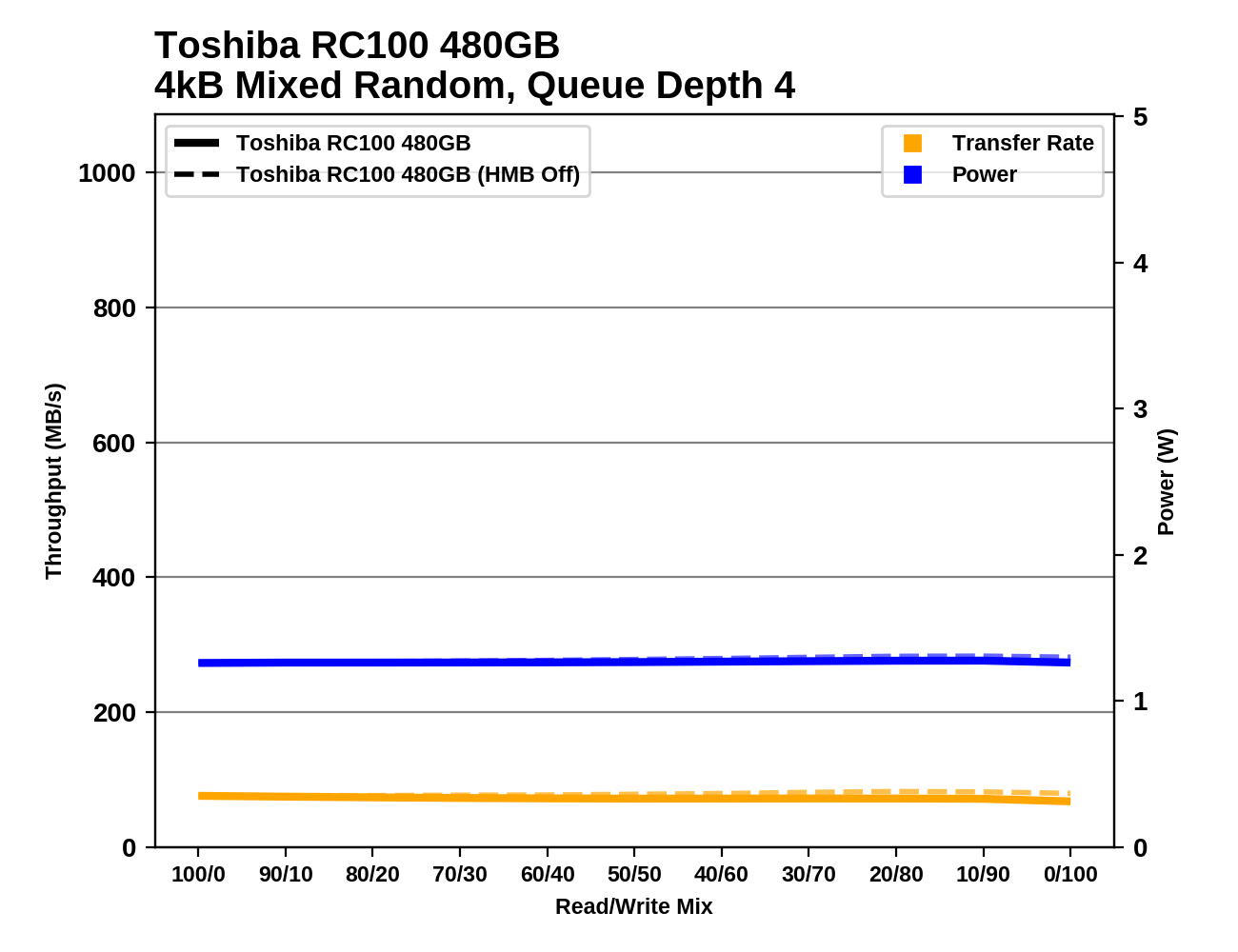The Toshiba RC100 SSD Review: Tiny Drive In A Big Market
by Billy Tallis on June 14, 2018 9:00 AM ESTMixed Random Performance
Our test of mixed random reads and writes covers mixes varying from pure reads to pure writes at 10% increments. Each mix is tested for up to 1 minute or 32GB of data transferred. The test is conducted with a queue depth of 4, and is limited to a 64GB span of the drive. In between each mix, the drive is given idle time of up to one minute so that the overall duty cycle is 50%.

Mixed workloads are often the toughest for DRAMless SSDs, and with this mixed random I/O test covering 64GB of the drive, the Toshiba RC100's Host Memory Buffer is of little use. The RC100 is substantially slower than other NVMe drives on this test.
 |
|||||||||
| Power Efficiency in MB/s/W | Average Power in W | ||||||||
Power efficiency from the RC100 during the mixed random I/O test is also poor, but it's not a significant outlier compared from the competition. Total power consumption is half a Watt lower than any of the other NVMe drives.
 |
|||||||||
The performance and power consumption of the Toshiba RC100 are remarkably constant across the varying workload of this test. There's no sign of improved performance as the fraction of writes increases, which gives most SSDs the opportunity to perform more write combining.
Mixed Sequential Performance
Our test of mixed sequential reads and writes differs from the mixed random I/O test by performing 128kB sequential accesses rather than 4kB accesses at random locations, and the sequential test is conducted at queue depth 1. The range of mixes tested is the same, and the timing and limits on data transfers are also the same as above.

On the mixed sequential I/O test, the Toshiba RC100 is a decent performer with an average that exceeds what any SATA SSD is capable of. HMB is a bit of help here because the sequential access pattern is very cache-friendly even though the test spans a wider range of data than the cache can track.
 |
|||||||||
| Power Efficiency in MB/s/W | Average Power in W | ||||||||
The Toshiba RC100's power efficiency on the mixed sequential I/O test is great with or without HMB. The RC100 is clearly much slower than the high-end drives, but its power consumption is reduced proportionally.
 |
|||||||||
The performance and power consumption of the Toshiba RC100 are not quite as flat on the mixed sequential test as for the mixed random I/O test. The RC100 gets a bit faster as the workload shifts toward writes, and HMB becomes more beneficial with increasing write volume.










62 Comments
View All Comments
bug77 - Thursday, June 14, 2018 - link
I'm talking about what is, you're talking wishful thinking.PCIe is supposed to cater to a lot of devices, it can't change its sleep current just because of one type of devices in particular. Not saying it's impossible, just that it's highly unlikely.
PeachNCream - Monday, June 18, 2018 - link
Since SATA has not been entirely replaced by NVMe yet, there is still time (and lots of it really) for changes. It's simply a matter of a drive identifying itself to the PCIe bus and then making on-the-fly sleep state changes. Yes, that's non-trivial, but far from wishful thinking.Gasaraki88 - Thursday, June 14, 2018 - link
SATA needs to go away. That is old technology for old drives. NVMe should be the new standard for hard drives, just like SAS was a better protocol than SATA, NVMe has less overhead and is designed for NAND storage.Targon - Thursday, June 14, 2018 - link
Space, and because people like these super-thin machines. Also, without the extra packaging, it may be less expensive to make a card based SSD compared to a 2.5 inch SSD drive. Smaller=cheaper when it comes to shipping/packaging as well.SATA hasn't really had any evolution over the past few years as well, so without something big to hype, SATA isn't a buzz word that attracts buyers. No SATA 4 standard, so they can't say it is the latest and greatest, while card based SSDs have an appeal as seeming to be a newer technology.
HStewart - Thursday, June 14, 2018 - link
One thing I am curious about is what performance do you need for SSD in external USB drive - I have a couple of them. These cheaper drivers are probably good for that purposetimecop1818 - Thursday, June 14, 2018 - link
Except cheap USB to M.2 adapters ONLY support SATA drives. The review unit is NVMe.Targon - Thursday, June 14, 2018 - link
USB 3.1 at the minimum if you want an external SSD in my opinion.HStewart - Thursday, June 14, 2018 - link
The one I am using ( actually two of them ) is WavLink USB 3.1 Gen 2 that actually does 10gbs 'https://www.amazon.com/gp/product/B06Y5XJG8J/ref=o...
It is not intended be primary storage - but works quite nice for my needs.
One thing some one should come out with lower cost TB3 drive case - right now they are at premium.
peevee - Thursday, June 14, 2018 - link
I wonder who would possibly buy the 120GB version given that only extra #20 will bring it to useful capacity and performance?Jorgp2 - Thursday, June 14, 2018 - link
Could you elaborate on how to configure the Host Memory Buffer Size?